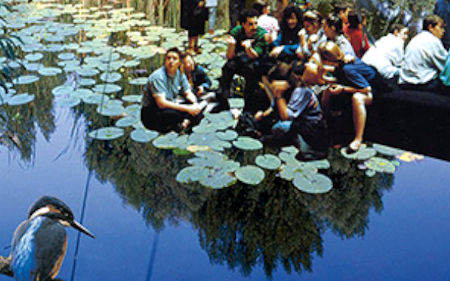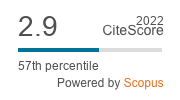Demographic changes and the demands on agricultural landscapes: Reflections on a new research topic
DOI:
https://doi.org/10.3097/LO.200809Keywords:
Aging-effects, Agrarian landscapes, Lifestyles, Literature review, Non-commodity outputs, Politico-economic model, PreferencesAbstract
Demographic change suggests substantial effects on future societal demands on agricultural landscape use and thus on rural areas. Demographic change is thereby defined as both the decrease of the population and the shift in the age distribution ("aging") and in the spatial distribution ("rural flight" particularly of young people). The exploration of the research object is based on the starting hypothesis that the demands and preferences of an aging and urbanizing population are changing and have effects on the controlling state interventions, which are also reflected in the agricultural use of landscapes. After a short description of demographic change, a conceptual politico-economic model, which describes the transmission of demographic change on land use, through the analysis of group (age groups, groups of residences) demands on agrarian landscape use is presented. The focus is on the demand for land use related non-commodity outputs (NCO). The starting hypothesis is then examined using selected studies. The literature suggests that urban-rural dichotomy is likely to be greatly diminished. In addition, the urbanization of preferences is expected while preferences differentiated against heterogeneous cultural lifestyles seem to become even more important. However, without further research on the related topics, the basic issues cannot be clearly dealt with. Assumptions are finally made regarding changing societal demands for agrarian landscapes due to demographic change. The limitations of the selected approach and the identification of further research needs will be discussed in closing.
References
Artner, A., Frohnmeyer, U., Matzdorf, B., Rudolph, I., Rother, J., & Stark, G. (2006). Future Landscapes,
Brämer, R. (2013). Jugendreport Natur' 03 - Nachhaltige Entfremdung,
Brand, K. -., Fischer, C., & Hofmann, M. (2003). Lebensstile, Umweltmentalitäten Und Umweltverhalten in Ostdeutschland,
Braun, A. (2000). Wahrnehmung Von Wald Und Natur,
Downs, A. (1968).
Elschen, R. (1991). Gegenstand und anwendungsmöglichkeiten der agency-theorie. Zeitschrift Für Betriebswirtschaftliche Forschung, 43(11), 1002-1012.
Frey, B. S. (1981).
Hampicke, U. (2003). Die monetäre bewertung von naturgütern zwischen ökonomischer theorie und politischer umsetzung. Agrarwirtschaft, 52, 408-418.
Heemskerk, M., Wilson, K., & Pavao-Zuckerman, M. (2003). Conceptual models as tools for communication across disciplines. Ecology and Society, 7(3) doi:10.5751/es-00554-070308
Helming, K., & Wiggering, H. (2003). Sustainable Development of Multifunctional Landscapes,
Hofinger, G. (2001). Denken Über Umwelt Und Natur,
Hofreither, M. F., Artner, A., Schmid, E., & Sinabell, F. (2002). Environmentally counterproductive support measures in austria: Agriculture. Environment and Water Management,
Hunziker, M. (2000). Einstellungen Der Bevölkerung Zu Möglichen,
Hunziker, M., & Buchecker, M. (1999). Bedürfnisorientierte landschaftsentwicklung im gebirgsraum - ergebnisse sozialwissenschaftlicher untersuchungen. Forum Für Wissen, 2, 1-8.
Inglehart, R. (1977). The Silent Revolution: Changing Values and Political Styles among Western Publics,
Ipsen, D., Reichardt, U., Schuster, S., Wehrle, A., & Weichler, H. (2003). Zukunft landschaft. Landschaftsplanung 153,
Klages, H. (2001). Brauchen wir eine rückkehr zu traditionellen werten? Aus Politik Und Zeitgeschichte, B29, 7-14.
Kleinhückelkotten, S., & Wippermann, C. (2007). Kommunikation für eine nachhaltige waldwirtschaft in deutschland beitrag zum 39. Forstpolitikertreffen,
Kröhnert, S., van Olst, N., & Klingholz, R. (2004).
Kuckartz, U., & Grunenberg, H. (2002). Umweltbewußtsein in deutschland 2000. ergebnisse einer repräsentativen bevölkerungsumfrage. Umweltbewusstsein in Deutschland 2002,
Kühne, O. (2006). Landschaft in der postmoderne. Das Beispiel Des Saarlandes,
Kujath, H. J., & Schmidt, S. (2007). Umbau von städten und regionen in nordostdeutschland - handlungsnotwendigkeiten und perspektiven. akademie für raumforschung und landesplanung. Räumliche Konsequenzen Des Demographischen Wandels Teil, 9
Lantermann, E. D., Reusswig, F., Schuster, K., & Schwarzkopf, J. (2003). Lebensstile und naturschutz. zur bedeutung sozialer typenbildung fü r eine bessere verankerung von ideen und projekten des naturschutzes in der bevölkerung. Zukunftsfaktor Natur - Blickpunkt Mensch, , 127-244.
Lee, T. R. (2001). Perceptions, attitudes and preferences in forests and woodlands. Perceptions, Attitudes and Preferences in Forests and Woodlands,
Mander, Ü., Wiggering, H., & Helming, K. (2007). Multifunctional land use: Meeting future demands for landscape goods and services. Multifunctional land use: Meeting future demands for landscape goods and services (pp. 1-421) doi:10.1007/978-3-540-36763-5
Olson, M. (1965). The Logic of Collective Action,
O'Neill, J., & Walsh, M. (2000). Landscape conflicts: Preferences, identities and rights. Landscape Ecology, 15(3), 281-289. doi:10.1023/A:1008123817429
Petersen, H. -., & Müller, K. (1999).
Philipp, H. -. (2005). Finanzielle Honorierung Der Landwirtschaftlichen Söllepflege in Norddeutschen Jungmoränengebieten Ergebnisse Von Bürger- Und Bauernumfragen in Brandenburg Und Berlin,
Preisendörfer, P. (1999). Umwelteinstellungen und umweltverhalten in deutschland. Umwelteinstellungen Und Umweltverhalten in Deutschland,
Reusswig, F. (2002). Lebensstile und naturorientierungen gesellschaftliche naturbilder und einstellungen zum naturschutz. Konzepte, Befunde Und Potentiale Leske+Budrich; Opladen, , 156-180.
Rodewald, R., Knoepfel, P., Gerber, J. -., Mauch, C., & Kummli Gonzalez, I. (2003). Die Anwendung Des Prinzips Der Nachhaltigen Entwicklung Für Die Ressource Landschaft,
Tarrant, M. A., Porter, R., & Cordell, H. K. (2002). Sociodemographics, values, and attitudes. Southern Forest Resource Assessment, , 175-187.
Van Den Berg, A. E. (1999). Individual differences in the aesthetic evaluation of natural landscapes. Individual Differences in the Aesthetic Evaluation of Natural Landscapes,
Vatn, A. (2001). , 23.
Vogel, S. (1999). Umweltbewusstsein und landwirtschaft theoretische überlegungen und empirische befunde. sozialwissenschaftliche schriften zur landnutzung und ländlichen entwicklung bd 34. Indicators for Multifunctional Land use - Linking Socioeconomic Requirements with Landscape Potentials Ecological Indicators, 6, 238-249.
Wilson, M. A., & Hoehn, J. P. (2006). Valuing environmental goods and services using benefit transfer: The state-of-the art and science. Ecological Economics, 60(2), 335-342. doi:10.1016/j.ecolecon.2006.08.015
Wüstemann, H. (2007). Multifunktionalität Der Landwirtschaft Und Non Commodity Outputs - Theoretische Betrachtung Und Empirische Analyse,
Wüstemann, H., Mann, S., & Müller, K. (2008). Multifunktionalität - Von Der Wohlfahrtsökonomie Zu Neuen Ufern,
Zander, P., Groot, J. C. J., Josien, E., Karpinski, I., Knierim, A., Meyer, B. C., . . . Rossing, W. A. H. (2008). Farm models and economic valuation in the context of multifunctionality: A review of approaches from france, germany, the netherlands and portugal. International Journal of Agricultural Resources, Governance and Ecology, 7(4-5), 339-360. doi:10.1504/ijarge.2008.020084

Downloads
Published
How to Cite
Issue
Section
License
Copyright (c) 2019 Klaus Müller, Astrid Artner, Andrea Knierim

This work is licensed under a Creative Commons Attribution 4.0 International License.










